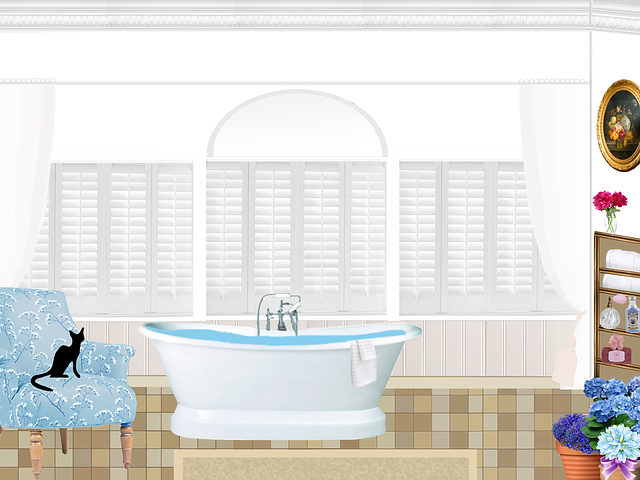Layered lighting, combining multiple sources at different heights and intensities, significantly enhances both aesthetics and practicality in homes or offices, particularly in bathrooms. Natural bathroom lighting can be maximized through strategically placed windows and skylights, transforming spaces into inviting oases with brightness, a connection with nature, and an airy ambiance. Artificial lighting, including overhead lights, wall-mounted sconces, and table lamps, creates depth and warmth while catering to diverse needs. A balanced lighting system should seamlessly integrate ambient, task, and accent lighting, with even light distribution and the right color temperature, emphasizing natural bathroom lighting while creating a safe, comfortable, and inviting space.
Discover the transformative power of layered lighting in functional spaces with our comprehensive guide. From understanding the benefits of a multi-layered approach to mastering natural bathroom lighting options, this article covers it all. We explore how to integrate artificial lights seamlessly for optimal functionality and ambiance while offering expert tips on designing balanced lighting systems. Enhance your space’s beauty and practicality through strategic illumination, especially focusing on maximizing those desirable natural bathroom lighting options.
- Understanding Layered Lighting and Its Benefits for Functional Spaces
- The Role of Natural Light in Bathrooms: Maximizing Natural Bathroom Lighting Options
- Integrating Artificial Lighting for Optimal Functionality and Ambiance
- Designing a Balanced Lighting System: Tips for Achieving the Perfect Harmony
Understanding Layered Lighting and Its Benefits for Functional Spaces
Layered lighting, a sophisticated approach to illuminating spaces, offers a multitude of advantages for functional areas within homes or offices. By incorporating multiple light sources at different heights and intensities, this technique creates depth and dimension, enhancing both aesthetics and practicality. In a natural bathroom lighting scenario, for instance, layering can transform the space from clinical to inviting. A combination of overhead fixtures, wall-mounted lamps, and strategically placed candles or small floor lamps ensures no corner goes unlit while providing options for mood and task lighting.
This method allows users to customize illumination based on activities and personal preferences at any given time. For example, during a relaxing bath, dimmed overhead lights and a warm glow from a wall-mounted lamp can create a soothing ambiance. Conversely, when getting ready in the morning, bright, focused task lighting ensures clarity and efficiency. Layered lighting’s versatility and adaptability make it an invaluable tool for designing functional spaces that are both visually appealing and adaptable to various activities and moods.
The Role of Natural Light in Bathrooms: Maximizing Natural Bathroom Lighting Options
Natural light plays a crucial role in creating functional and inviting spaces, especially in bathrooms. It not only enhances the overall aesthetic but also has positive impacts on our well-being and daily routines. In the context of bathroom design, maximizing natural light becomes an essential consideration to transform these often overlooked areas into serene oases.
One of the primary natural bathroom lighting options is strategically placed windows that allow sunlight to flood in, instantly brightening up the space. Large, south-facing windows are ideal as they capture the sun’s rays during the day, providing ample illumination and a connection with the outdoors. For smaller bathrooms, skylights can be game-changers, offering both natural light and ventilation. By combining these options, one can create an atmosphere that feels open, airy, and refreshing—a far cry from the often confined and dimly lit perception of bathrooms.
Integrating Artificial Lighting for Optimal Functionality and Ambiance
In the pursuit of functional spaces that double as inviting and aesthetically pleasing environments, artificial lighting plays a pivotal role. When it comes to bathrooms, where natural light availability can vary greatly, incorporating strategic artificial lighting solutions is key to achieving both optimal functionality and ambiance. Natural bathroom lighting is essential for tasks like shaving or applying makeup, making adjustable and directionable artificial fixtures crucial. These allow users to control the intensity and distribution of light, ensuring clear visibility without harsh glare.
Layered lighting options are particularly beneficial here. For instance, a combination of overhead lights, wall-mounted sconces, and table lamps can create depth and mood while catering to diverse needs. Overhead lights provide general illumination, while sconces offer task lighting near mirrors or sinks. Table lamps add ambient warmth and flexibility, allowing users to adjust light levels according to personal preference at any given time of day or night. This integration ensures that bathrooms remain functional work spaces while cultivating a welcoming atmosphere.
Designing a Balanced Lighting System: Tips for Achieving the Perfect Harmony
When designing a balanced lighting system for functional spaces like bathrooms, the goal is to create an environment that’s both inviting and practical, with a focus on natural bathroom lighting. Start by considering the different types of light sources—ambient, task, and accent—and their roles in setting the mood and enhancing functionality. Ambient lighting provides overall illumination, while task lighting targets specific activities like shaving or applying makeup. Accent lighting adds drama and draws attention to key features.
To achieve harmony, integrate these elements seamlessly. For instance, a combination of recessed ceiling lights for ambient coverage, a stylish lamp for task lighting near the sink, and subtle wall sconces as accents can create a balanced and inviting bathroom space. Pay attention to light color temperature—warmer tones evoke coziness while cooler temperatures stimulate energy—and adjust accordingly. Natural bathroom lighting should be well-distributed, avoiding harsh shadows and ensuring every area is illuminated evenly for safety and comfort.
Layered lighting is a versatile tool that enhances both functionality and aesthetics in any space, with bathrooms being no exception. By combining natural and artificial lighting sources, you can create a balanced environment that’s both inviting and practical. Understanding how to maximize natural bathroom lighting options and integrate artificial lights strategically ensures optimal visibility while preserving the ambiance. Following the tips outlined in this article, you can design a harmonious lighting system for your functional spaces, transforming them into serene oases where form meets function beautifully.
